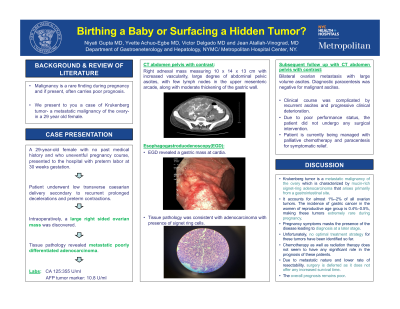Back


Poster Session E - Tuesday Afternoon
Category: Stomach
E0710 - Birthing a Baby or Surfacing a Hidden Tumor?
Tuesday, October 25, 2022
3:00 PM – 5:00 PM ET
Location: Crown Ballroom

Has Audio

Niyati Gupta, MD
Metropolitan Hospital
New York, NY
Presenting Author(s)
Niyati Gupta, MD1, Yvette Achuo-Egbe, MD, MPH, MS2, Victor Delgado, MD1, Jean Atallah-Vinograd, MD1
1Metropolitan Hospital, New York, NY; 2New York Medical College/ NYCHH - Metropolitan Hospital Center, New York, NY
Introduction: Malignancy is a rare finding during pregnancy and if present, often carries poor prognosis. We present to you a case of Krukenberg tumor- a metastatic malignancy of the ovary- in a 29 year old female.
Case Description/Methods: A 29-year-old female with no past medical history, presented to the hospital with preterm labor at 30 weeks gestation which lead to low transverse caesarian delivery secondary to recurrent prolonged decelerations and preterm contractions. Patient had an uneventful pregnancy course until this hospitalization. Intraoperatively, a large right sided ovarian mass was discovered. Tissue pathology revealed metastatic poorly differentiated adenocarcinoma. CT scan of the abdomen pelvis was suggestive of right adnexal mass measuring 10 x 14 x 13 cm with increased vascularity, large degree of abdominal pelvic ascites, with few lymph nodes in the upper mesenteric arcade, along with moderate thickening of the gastric wall. Esophagogastroduodenoscopy(EGD) revealed a gastric mass at cardia [Figure 1a], and tissue pathology was consistent with adenocarcinoma with presence of signet ring cells [Figure 1b]. Additional work up was positive for elevated CA 125 and AFP tumor marker measuring 355 U/ml and 10.8 U/ml, respectively.
Subsequent follow up with CT abdomen revealed bilateral ovarian metastasis with large volume ascites. Diagnostic paracentesis was negative for malignant ascites. Clinical course was complicated by recurrent ascites and progressive clinical deterioration. Due to poor performance status, the patient did not undergo any surgical intervention. Patient is currently being managed with palliative chemotherapy and paracentesis for symptomatic relief.
Discussion: Krukenberg tumor is a metastatic malignancy of the ovary which is characterized by mucin-rich signet-ring adenocarcinoma that arises primarily from a gastrointestinal site. It accounts for almost 1%–2% of all ovarian tumors. The incidence of gastric cancer in the women of reproductive age group is 0.4%–0.5%, making these tumors extremely rare during pregnancy. Pregnancy symptoms masks the presence of the disease leading to diagnosis at a later stage. Unfortunately, no optimal treatment strategy for these tumors have been identified so far. Chemotherapy as well as radiation therapy does not seem to have any significant role in the prognosis of these patients. Due to metastatic nature and lower rate of resectability, surgery is deferred as it does not offer any increased survival time. The overall prognosis remains poor.

Disclosures:
Niyati Gupta, MD1, Yvette Achuo-Egbe, MD, MPH, MS2, Victor Delgado, MD1, Jean Atallah-Vinograd, MD1. E0710 - Birthing a Baby or Surfacing a Hidden Tumor?, ACG 2022 Annual Scientific Meeting Abstracts. Charlotte, NC: American College of Gastroenterology.
1Metropolitan Hospital, New York, NY; 2New York Medical College/ NYCHH - Metropolitan Hospital Center, New York, NY
Introduction: Malignancy is a rare finding during pregnancy and if present, often carries poor prognosis. We present to you a case of Krukenberg tumor- a metastatic malignancy of the ovary- in a 29 year old female.
Case Description/Methods: A 29-year-old female with no past medical history, presented to the hospital with preterm labor at 30 weeks gestation which lead to low transverse caesarian delivery secondary to recurrent prolonged decelerations and preterm contractions. Patient had an uneventful pregnancy course until this hospitalization. Intraoperatively, a large right sided ovarian mass was discovered. Tissue pathology revealed metastatic poorly differentiated adenocarcinoma. CT scan of the abdomen pelvis was suggestive of right adnexal mass measuring 10 x 14 x 13 cm with increased vascularity, large degree of abdominal pelvic ascites, with few lymph nodes in the upper mesenteric arcade, along with moderate thickening of the gastric wall. Esophagogastroduodenoscopy(EGD) revealed a gastric mass at cardia [Figure 1a], and tissue pathology was consistent with adenocarcinoma with presence of signet ring cells [Figure 1b]. Additional work up was positive for elevated CA 125 and AFP tumor marker measuring 355 U/ml and 10.8 U/ml, respectively.
Subsequent follow up with CT abdomen revealed bilateral ovarian metastasis with large volume ascites. Diagnostic paracentesis was negative for malignant ascites. Clinical course was complicated by recurrent ascites and progressive clinical deterioration. Due to poor performance status, the patient did not undergo any surgical intervention. Patient is currently being managed with palliative chemotherapy and paracentesis for symptomatic relief.
Discussion: Krukenberg tumor is a metastatic malignancy of the ovary which is characterized by mucin-rich signet-ring adenocarcinoma that arises primarily from a gastrointestinal site. It accounts for almost 1%–2% of all ovarian tumors. The incidence of gastric cancer in the women of reproductive age group is 0.4%–0.5%, making these tumors extremely rare during pregnancy. Pregnancy symptoms masks the presence of the disease leading to diagnosis at a later stage. Unfortunately, no optimal treatment strategy for these tumors have been identified so far. Chemotherapy as well as radiation therapy does not seem to have any significant role in the prognosis of these patients. Due to metastatic nature and lower rate of resectability, surgery is deferred as it does not offer any increased survival time. The overall prognosis remains poor.

Figure: Figure 1a: EGD revealing gastric mass at cardia
Figure 1b: Tissue pathology showing adenocarcinoma with presence of signet ring cells
Figure 1b: Tissue pathology showing adenocarcinoma with presence of signet ring cells
Disclosures:
Niyati Gupta indicated no relevant financial relationships.
Yvette Achuo-Egbe indicated no relevant financial relationships.
Victor Delgado indicated no relevant financial relationships.
Jean Atallah-Vinograd indicated no relevant financial relationships.
Niyati Gupta, MD1, Yvette Achuo-Egbe, MD, MPH, MS2, Victor Delgado, MD1, Jean Atallah-Vinograd, MD1. E0710 - Birthing a Baby or Surfacing a Hidden Tumor?, ACG 2022 Annual Scientific Meeting Abstracts. Charlotte, NC: American College of Gastroenterology.

